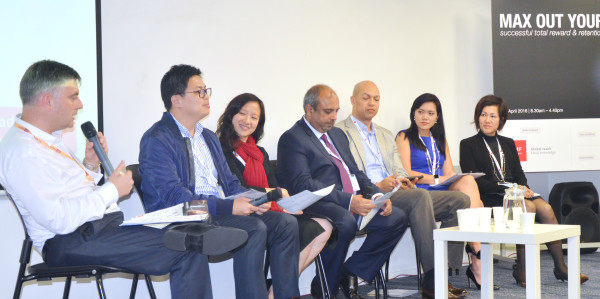
Moderator: Paul Arkwright, Editor-in-Chief, HR Magazine; The Panel from left to right: Alex Yeung, Director—Human Resources Shared Services, Asia Pacific, Avery Dennison; Bianca Wong, Group Human Resources & Corporate Communications Director, Jebsen & Co. Ltd; Rizwan Masood, Head of HR—Retail Banking Greater China and North Asia, Standard Chartered Bank; Charles Hughley, General Manager—Talent Management, Human Resources, Johnson Electric; Lien Chu, Area Director of Human Resources & Training, Hotel Jen; Flora Chan, Head of Human Resources, United Overseas Bank Hong Kong
The panel started off by considering the issue of how EVP has changed over time. Flora Chan, Head of Human Resources, United Overseas Bank Hong Kong opened up by talking about how EVP and employer branding has become intricately linked. She shared, “When we first started, the talent we required was quite limited but as we have expanded, we need a diversity of talent, and those from the younger generations respond well to branding. This is particularly important for a less visible brand.”
Lien Chu, Area Director of Human Resources & Training, Hotel Jen explained how this change impacted its sister company, Shangri-La. She explained, “With the next generation of emerging young leaders and a highly saturated market in our industry, we had to ask ourselves what we needed to do in our employer branding to stand out from our competitors. From dialogues and research, we knew that graduates thrive off a sense of adventure and overseas exposure. They also appreciate hearing first-hand experiences from recent graduates. So instead of doing campus presentations where senior management share their life stories, we arranged live simultaneous video conversations with Management Trainees from around the world so that students could engage with them and hear about their personal journey within Shangri-La. This small step was a huge leap toward achieving higher conversion ratios.”
The challenge of the EVP is buy-in. Charles Hughley, General Manager—Talent Management, Human Resources, Johnson Electric commented, “EVP should be understood from an organisational standpoint. It is critical that the EVP should be a message which communicates both who we are and who we aspire to be. For this, you need to communicate and engage with your senior leaders and employees. We found that when it comes to engaging with our employees, it’s a rich and meaningful dialogue. We view our EVP as a journey which evolves as we evolve but with our values at the core.”
Rizwan Masood, Head of HR—Retail Banking, Greater China and North Asia, Standard Chartered Bank added, “Trainees don’t want to undergo a three-year training programme. As such, we improvise and change programmes over time, and cater to their interests.”
Then it is a case of selling EVP to the outside world. In this respect, there is a difference in how companies market themselves. Bianca Wong, Group Human Resources & Corporate Communications Director, Jebsen & Co Ltd stated, “We are the force behind several well-known brands. So, the kind of culture we want to promote is one that is experience-driven but sustainable and reliable for candidates.”
Meanwhile, Chu highlighted that the culture at Hotel Jen attracts their young client base. She added, “The top drivers for employee engagement are based on the same eight brand promises we make to our guests. What we promise to our external guests, we also deliver to our internal guests— the staff love the culture, and they live and breathe it.”
Measuring success is quite important too. Alex Yeung, Director—Human Resources Shared Services, Asia Pacific, Avery Dennison said, “The way we do this is through an employee engagement survey. This helps us to cross-check from an employee perspective about how we do. It gives us key indications about what we need to be focused on. This helps us to improve and exceed the expectations of our employees.”




